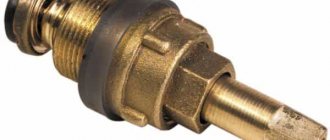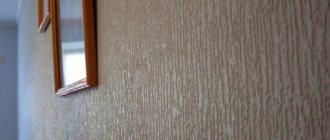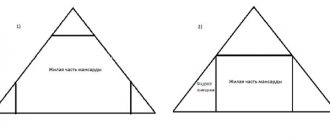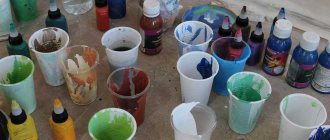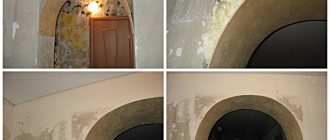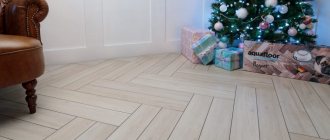Currently, finishing country houses with brick is very common.
Brick finishing gives the building an aesthetic appearance and looks quite expensive. However, often the masonry does not have a very attractive appearance and has remnants of adhering concrete. And here the question arises - how to clean the brick from the mortar? It can also occur when using old dismantled masonry material. There are several cleaning methods. When choosing a method, you need to take into account the nuances of the type of surface, amount and structure of contamination. There are mechanical and chemical methods.
It should also be taken into account that each type of brick has an individual approach to cleaning. So, for example, to clean silicate cement from cement, you cannot use chemical solutions, since such treatment will lead to its scattering.
Efflorescence-resistant materials
- Clinker brick
is a cladding material with high protective properties. It protects the walls of buildings from rain and snow, and is also particularly reliable and durable. If efflorescence does appear on clinker tiles, it is quite easy to remove it with plain water or weakly concentrated cleaning agents. After removal, the walls are treated with products containing silicones. - The fifth element is a facing brick of very good quality, but it costs much more than usual.
TOP 9 stores where I shop profitably
- Petrovich - construction-trading house
- InstrumTorg
- Leroy Merlin
- Stroylandia- Construction and finishing materials
- OBI - building materials and everything for the home
- Building yard
- Maxidom
- All Tools
- Garage Tools
TOP 7 for goods and furniture for the home:
- Brownie
- Furniture for home
- HomeX - everything for decoration
- Designer furniture
- Furniture and kitchens to order
- 220 Volt - Tools for home
- MVideo equipment for home
Preparation
The preparatory process can be divided into two stages.
Instrument
To ensure that the process of removing lime from the walls goes as quickly as possible, you must ensure that you have the following tools in advance:
soft sponges;- spatula (wide and narrow);
- spray;
- ladder;
- rolls;
- water container;
- rags, rags for cleaning.
Lime removal work cannot be carried out without personal protective equipment. Construction glasses, a respirator, a headscarf or scarf, and work clothes will protect the skin and mucous membranes from fine particles of lime in the air and splashes of dirty water.
Premises
To prevent the whitewash removal process from developing into a global cleaning, it is necessary to cover the floor covering with plastic film or sheets of plywood .
Windows and doors are also covered as much as possible with cloth or polyethylene (lime splashes leave white spots that are quite difficult to wash off). Before work begins, especially valuable items and furniture are removed from the premises.
Facilities
When one or another option for cleaning brick is chosen, you need to prepare special products.
If you plan to use a mechanical method to clean the surface of the masonry layer, you need to prepare:
- brush for metal processing;
- trowel (sometimes replaced with a spatula);
- a block covered with emery;
- chisel;
- chisel;
- medium sized hammer.
But since any hand and electric tool creates dust during operation and throws out abrasive particles, you need to take care of devices to protect your health. You can only work with such a tool wearing a respirator and special glasses.
Important: gloves should be worn. When cleaning bricks, clothing should be durable and non-marking; even if she gets dirty, you shouldn't feel sorry for her
If you plan to use special chemicals, you will definitely need the same respirators, goggles and rubber gloves.
To remove dirt from sand-lime bricks mechanically, use:
- steel brushes;
- electric drills and attachments for them;
- emery.
It is necessary to moisten stains and deposits on silicate material in any case. This will greatly simplify the work. Solvents are purchased ready-made or prepared independently - it depends on material capabilities and skills. In most cases, sulfuric and hydrochloric acid helps clean the surface.
Important: they cannot be used in pure form or in concentrated solutions; dilution up to 10% is required.
Chemical cleaning is completed by washing the surface with running water. This will remove caustic substances along with undissolved particles. Special preparations are applied to contaminated areas of brick with brushes, rollers or brushes. It is recommended to combine chemical and mechanical cleaning. Clogs softened by chemicals are removed with spatulas and chisels (if the stains are large), or steel brushes (when it is necessary to remove small marks and dots, specks).
Video
This video shows how you can clean brick from not very hardened and completely dried mortar:
Currently, finishing country houses with brick is very common. Brick finishing gives the building an aesthetic appearance and looks quite expensive. However, often the masonry does not have a very attractive appearance and has residues of adhesion. And here the question arises - how to clean the brick from the mortar? It can also occur when using old dismantled masonry material.
There are several cleaning methods. When choosing a method, you need to take into account the nuances of the type of surface, amount and structure of contamination. There are mechanical and chemical methods.
It should also be taken into account that each type of brick has an individual approach to cleaning. So, for example, to clean silicate cement from cement, you cannot use chemical solutions, since such treatment will lead to its scattering.
This method is suitable for almost any type of masonry brick, but if there is a high risk of damage to the surface, then it is better to use chemical solutions. This option is not suitable for removing small errors.
In the work they use tools such as a metal brush, trowel, and hammer. For small growths, use brushes, but for massive ones, it is better to use a heavier device.
To avoid notching the brick, blows are applied along the surface. After breaking off large pieces, these places are treated with sandpaper
When mechanically cleaning, it is important to consider some rules to prevent unwanted consequences.
To clean silicate and ceramic bricks, you need to use different methods because cement on silicate bricks holds much stronger. To clean the voluminous slats of sand-lime and red bricks, use a drill, hammer drill or grinder. If the cement layer is small, it is better to use a grinding machine.
What accelerates and makes possible the appearance of limescale efflorescence?
- High Water/Cement ratio.
- Insufficient mixing of the masonry mixture.
- Large amounts of Ca(OH) 2 (calcium salts) and other foreign salts in mixtures.
- Insufficient content of binder (cement) in masonry mixtures (increasing porosity and, accordingly, water permeability).
- Poor seam care – incorrect seam profile.
- Poorly prepared mixture - movement of water and lime.
- Filler not washed from impurities
- Filler of uncontrolled composition and quality.
- The water is highly chlorinated, containing salt or other foreign substances, which contributes to prolonged drying.
- Filling joints with mortar after precipitation until the base is completely dry.
- Drying of cement mixtures too quickly.
Cleaning methods
Various options for cleaning brick have been developed, each of which has its own scope of application. Sometimes, if the contamination is very strong, you have to combine two or more methods. A water jet supplied under pressure effectively removes salt crusts and other stains. Existing systems can supply water at a pressure of 15-220 bar. Although this pressure is high, the technology has been developed so well that the material is not damaged, and in addition, it is environmentally friendly.
Instead of water, jets of sand can also be used. Devices that supply it can guarantee the release of bricks from the following contaminants:
- old dyes;
- bitumen;
- fuel oil and other petroleum products;
- mold stains;
- cement splashes and crusts;
- traces of corrosion.
Sand supplied under significant pressure also exerts increased pressure on the surface. This helps remove all inclusions that worsen the appearance of the wall or other structure. Along with the two named options, the mechanical method is quite widely used. It helps to remove all hardened substances, including drips of building mixtures and paints. For work, various hand tools are used to chip away cement mortar and other blockages.
But it is inconvenient to remove very small stains using a chisel, chisel, etc. In addition, they can damage the surface. Therefore, the final processing is carried out using coarse-grained emery. To guarantee a positive result, after abrasive treatment, it is necessary to rinse the brick with a stream from a hose. This will wash away all dust particles. But all mechanical influences, even the gentlest ones, can damage a brick wall. Therefore, chemicals are also widely used. Helps to dissolve blockages:
- phosphorus;
- sulfuric;
- hydrochloric acid.
Cement solvents
Cement mixture residues are easily removed using acid-containing solvents. They penetrate into the contaminants, destroying them from the inside, after which the softened solution is easily removed mechanically. Solvent cleaning is used to remove cement from ceramic bricks, but it cannot be used when cleaning sand-lime brickwork, since the latter is destroyed by acids. You can purchase acid for preparing a solvent at any construction supply store; you just need to carefully read the instructions for use, since different acids are diluted and used in different ways.
Battery acid is also used, which is diluted in water in a ratio of no more than one to ten. It is applied to the moistened brick and then left for 10-30 minutes. Further contamination can be easily removed by mechanical means.
Work is carried out only when using reliable protective equipment.
What are the cleaning methods?
Sometimes after construction work, the brickwork needs to be cleaned of paint, plaster, or the remains of concrete must be removed from it. There are several types of cleaning that allow you to wipe away dirt from the structure:
- mechanical - cleaning of sand-lime brick;
- washing with water;
- use of special solutions.
To clean a brick wall from foreign material, you need to prepare in advance the following tools:
- metal scraper, brush, spatula, chisel;
- bucket;
- drill with replaceable attachments;
- gauze mask or respirator;
- gloves.
From white plaque
The salts that the cement mortar contains penetrate the surface of the brick and cause the appearance of a white coating on the masonry. It occurs after heavy rainfall. This phenomenon is dangerous because it can destroy the top layer of materials: cracks and chips appear. You can wash a brick facade from this plaque with a special blasting - a highly concentrated substance that is diluted with water, maintaining a ratio of 1:10. After this, they proceed according to the following algorithm:
- The liquid is applied with a brush to the red brick.
- Leave for 20-30 minutes to absorb.
- Wash off with clean water. This type of cleaning of brick walls from efflorescence is considered the most effective.
Cleaning bricks from grout
To wash off contaminated areas from facing bricks without difficulty, it is better to do this on the first day. Then, for removal, the wall is wetted and the residue is removed with a spatula. Cleaning the facade in this way is quick and without harm to the material. If the grout on the surface of the decorative brick is ingrained, proceed according to the following scheme:
- Select a special blasting agent and dilute it according to the instructions.
- Apply to the surface and leave for the required time.
- Remove the residue with a spatula.
From plaster
A popular method of decorating brickwork is applying plaster. However, such a coating requires updating over time, and the old material must be completely removed before cleaning. Here's how to properly clean your walls:
- Remove all furnishings from the room.
- Close doors and windows tightly to prevent dust from entering other rooms.
- Use a chisel and hammer to remove cement from the brick.
- Wipe the surface from dust.
- Apply special varnish.
After completing the work, it is necessary to wash the facing brick from any remaining dust. The washing procedure must be performed in the direction from the top corner. There is also a special cleaner for cleaning walls from plaster, but it takes longer and does not guarantee complete removal of material residues. Decorative, three-dimensional plaster containing gypsum can also be placed on the surface of the masonry material.
From cement
After completing construction work, it is necessary to clean the brick facade from the remains of the cement-sand mixture
To choose how to clean the masonry, you need to pay attention to the degree of contamination of the structure. It is best to clean bricks from mortar in the first 24 hours after contamination.
There are two ways to clean a building:
- Mechanical option. Involves treating the surface with a metal brush or chisel.
- Chemical method. A brick cleaning agent containing hydrochloric or phosphoric acid is used. Sand-lime brick cannot be cleaned this way.
From different types of paint
Very often, painting is chosen as a decoration for brick walls. However, if you want to lighten the silicate material for the purpose of further renewal, the coloring material must be removed. The method of soaking with vinegar was popular, but after the advent of special solutions it is practically not used. Sandblasting is often used, but it damages the masonry, which may eventually require partial or complete dismantling of the structure. Therefore, it is better to work according to this scheme:
- Scrape off old material.
- Treat surfaces with a special solution against fungus.
- Apply cleaning solution.
- Remove any remaining paint. If the work is carried out indoors, it is better to stick paper on the walls and remove the material with it.
From clay in the form of a solution
Sometimes the brick is “set” on clay instead of cement. This prevents the products from cracking during operation. The building material must be bleached from the rock immediately. While the solution has not hardened, this can be done with a dry cloth made of natural fabric. However, if the rock has dried out, you need to act differently. Clay mortar masonry is tidied up using the same technique as when cleaning a cement-sand mixture.
Operating principle
Retail chains offer various options for concrete cleaners, but almost all substances are a solution of hydrochloric or sulfuric acid of a certain concentration. When the product is applied to a contaminated surface, the acid enters into a chemical reaction with the cement.
The result of the chemical reaction is the softening of the dirt to a state where it can be cleaned off with any suitable tool or washed off with water. In addition, the acid cement cleaner includes the following auxiliary components:
- Corrosion inhibitor (protection) of metals and coatings.
- Substances that accelerate the process of converting concrete into an amorphous mass.
On sale you can find concentrated and ready-to-use (diluted in a certain proportion with water) cleaners. Considering the different nature and degree of contamination, it is best to purchase concentrated versions and dilute them with water yourself, following the following recommendations:
- Very old stains should be “softened” and cleaned with a concentrated solution as supplied.
- Fresh concrete and mortar will be removed by a product diluted in a ratio of 1 part cleaner to three parts water.
- Cement laitance deposits are removed with a mixture of concentrate and water in a ratio of 1:5.
- The surfaces of equipment and tools can be easily washed with a 1:10 solution with the addition of a small amount of liquid soap or dishwashing detergent.
In any case, you should follow the instructions for use of the manufacturer of the product and, in order to avoid discoloration or damage to the surface being cleaned, try the substance on a small area.
Remove paint from brick
Therefore, it is best to adhere to the following recommendations:
Perform initial paint removal. Get rid of fungus. Perform chemical treatment. Perform secondary paint removal.
First you need to remove the loose layer of paint. All visible wall surfaces on which peeling paint is visible are treated with a spatula. Then the wall is carefully brushed to remove dust.
The second stage is getting rid of the fungus. A special solution is prepared (bleach and water in a ratio of 3:1) and applied to the wall with a brush. After this, rinse thoroughly with water.
When the wall is completely dry, another solution is applied to it, which removes the remaining layer of paint chemically: caustic soda and water in a ratio of 1:3. A small amount of flour is gradually added to this solution until it becomes mushy.
The prepared solution is applied to the wall with a spatula and left for 2 days. After this, warm water from a hose (under high pressure) removes the solution from the surface along with the old paint.
If you need to clean a wall in your house, then while applying the solution to the walls, strips of paper are glued to it. It is then removed from the surface along with the paint.
Instead of a homemade solution, you can purchase a special solution in the store. To breed it you need to follow the instructions.
Options for further painting of the wall can be found in the article How to paint a brick wall
Advice from professionals
For high-quality cleaning of bricks, you can use the advice of professionals:
When cleaning from cement mortar, the brick can be moistened with water. The cement will absorb a small amount of moisture and come off easily. The chemical method of cleaning bricks from mortar is carried out only for red ceramic bricks. When using various chemical solutions to clean brick, you need to wear gloves and protective clothing. It is advisable to cover the floor with film. Before cleaning brick, it is best to do a test cleaning on a small area. This will help ensure that the product will not damage the surface of the material.
Removing plaque from brick using improvised means is quite simple. To speed up the work, you can purchase the solution in the store. The main thing is to follow the instructions for carrying out the work. Due to this, you can get a high-quality result.
How and with what to clean brick inside the house
Tools:
For convenience when you're working with a large area, make your life easier by placing your vacuum cleaner in a wheeled cart and working with it. Believe me, there is nothing worse than carrying a vacuum cleaner in your hands while cleaning large areas of brickwork or at heights.
Cleaning Fireplace Brick
Follow the instructions below to clean soot off your brick.
The only difference is the speed of action. Now you can run over a brick and not find a trace of dirt on the napkin, with the exception of red crumbs. Paradise!
Powerful brick cleaner
Try Antisolex, Neomid 550, Tiprom OC impregnation. These are strong cleaning solutions that are used by professional cleaning companies to clean smoke, mortar, plaster, cement, soot, efflorescence, salt, and paint. You can buy products at hardware and construction stores.
Since this is a strong product, be sure to wear rubber gloves and eye protection. Avoid getting the cleaner on your skin, walls, carpets or fabrics.
If soot and stains remain, you can repeat this process.
How and with what to clean brick outside
Cladding bricks and building bricks are low maintenance, looking clean even when they aren't.
Brushing after heavy rain or after several months of dry season will work well and will help maintain the appearance of the brick. Once a year you need to thoroughly clean the brick.
Dust and dirt
Change into clothes you are not particularly attached to, this job can be messy.
Turn the water hose on high and wash away all the dust and debris that has accumulated on the brick in recent months. Work from left to right and make sure to remove any dirt using different water pressures. Don't stand too close to the wall, otherwise you'll get a good dose of dirty water.
Clean away any remaining debris with a broom or, for extra thoroughness, a stiff brush. Rake all debris into a pile or, if there is little debris, use a vacuum cleaner to collect loose debris and brick chips.
Stubborn stains on brick
If you're going to be cleaning brick, you should be aware that this job can take up your whole day, but on a nice sunny day, it's a great job to even out your tan.
To clean stubborn stains, mix 1/2 cup of ammonia in a bucket of water. Scrub the brick with a stiff brush, then rinse thoroughly.
Removing fungus and mold
If the brick wall of your home has been left damp for a long time, you may notice mold or moss. If you don't want to leave this job to the professionals, get changed, grab your cleaning supplies, and let's fix the situation.
First, mix a solution of bleach and water in a bucket. Use 4 parts water to 1 part bleach. Next, either using a scraper or a putty knife, remove the moss and mold from the surface of the brick. Don't try to thoroughly clean every lump; you'll likely have to repeat the process.
Now, apply a cleaner of bleach and water to the brick (don't skimp). Leave the solution on during the day or overnight, depending on the amount of mold and the size of the job.
Complex mold and moss
If after you've cleaned the mold and moss off the walls of your home, you still see black spots in the tiny holes of the brick, use a stronger solution of bleach and water than before. Mix a 50/50 solution in a spray bottle, apply it to the surface and leave for a day or two. Then rinse and check again. You can repeat the process again if necessary.
Cautions
Do not use pressure washers on brickwork as they can damage and greatly change the appearance of the brick. This is especially true when it comes to old brick.
If you notice white spots (like powdery spots) on the brick, this is the process of flowering. Flowering of bricks is caused by excess moisture. Again, do not use pressure washers to clean. Find the source of the problem to ensure there is no over-watering, then wipe with clean water as above for normal dirt and dust.
Brick houses have an attractive façade and are worth the time you may spend cleaning them.
Say goodbye to grime on brick walls, fireplaces and pavers with these safe and effective cleaning methods.
Naturally weathered brick adds to its desirability inside and out, but too much dirt accumulation can reduce beautifully weathered bricks—not to mention the mortar between them—to unattractively blotchy masonry. Whether the exposed brick wall in your kitchen is covered in grease or your brick exterior is a mess of moss, you can prevent your brick from discoloring and deteriorating with the formulas and methods used here.
You'll need to prepare the surface before going to the dirt, but once you're done, your brick will be restored to its former glory and you'll once again be proud of the prominent place it occupies in your home.
How to clean brick indoors
Materials and tools for cleaning brick surfaces inside the house:
Step 1 Remove decorative items from the walls and cover the floors and furniture in the immediate area with a tarp or old newspaper to protect them from splashes of cleaning solvent.
Step 2 Remove loose dust and dirt from the surface of the brick using a vacuum cleaner with a brush attachment.
Step 3 Dry brick easily absorbs cleaning solvents, causing it to fade or become discolored with an unsightly white or greenish foam. To avoid this, use a spray bottle filled with water to saturate the dry brick before applying any cleaning products.
Step 4 Next, continue using one of the following two methods: scrub the brick with a paste of dish soap and salt, or scrub stains with boric acid .
How to Clean Brick Outdoors
Materials and tools needed for cleaning brickwork outdoors:
Step 1 Check the weather forecast: the optimal temperature for cleaning brick is 10 degrees or higher, preferably in cloudy conditions where cleaning solvents are less likely to dry quickly and leave behind residual stains.
Step 2 If necessary, use a tarp to cover nearby metal, wood and glass surfaces and to cover light fixtures, windows and plants near the brick to protect them from cleaning solvents.
Step 3 Thoroughly spray the dry brick with water from a garden hose.
Step 4 Once the brick is dry, continue using one of the following two exterior solutions: bleach or muriatic acid .
Now that your brick surfaces are smooth again, keep them that way by lightly spraying or watering them at least once a year when they start to show signs of aging.
How to clean various types of dirt with your own hands?
The choice of cleaning method is determined not only by the type of brick (ceramic or silicate), and not only by the severity of contamination
You also need to pay attention to how much area the clog covers and how quickly you need to get rid of it. Emergency cleaning of bricks is carried out with special preparations
If there is no need to rush, more environmentally friendly methods are preferable. Already among them they choose an approach, focusing on the type of coverage.
Next, the solution is removed mechanically. If concrete stains are flat in shape, they are usually removed with spatulas, trowels or high-hard brushes. If there are stone fragments on the surface, knock them off a little with a spatula. What remains is removed with a brush. But large inclusions can only be removed with a chisel and a hammer; other tools are impractical. When working, you need to strike accurately and without excessive force. Strikes at right angles are strictly unacceptable. The pressure on contaminated areas should be upward or downward relative to the wall. Once the unnecessary coating has been mostly removed, the brick wall will have to be sanded. But the work doesn’t end there - you still need to wash the surface, thereby getting rid of microscopic particles.
If the wall has stood for a long time, you often have to get rid of the salt. The approach to raids can vary significantly depending on their nature. Some of the salt stains are simply washed off by watering the façade or individual bricks with a hose. Sometimes you don’t even need to create a strong pressure; simple wetting is enough. But in other cases, stronger means are required - special preparations and a hard brush.
To return the appearance of old brick to normal, you will have to either act by trial and error, or follow the recommendations of sellers. They need to describe in detail the type of stains and layers (or better yet, show photographs). When diluting any drug, it is unacceptable to deviate from the ratios of water and working mixture prescribed in the instructions; The recommended processing time must also not be exceeded.
Of the available chemicals, a solution of hydrochloric acid is used to combat salt blockages. It can only be used to wet a thoroughly moistened substrate. When 10 minutes have passed, the wall is washed with a hose. As soon as the surface is 100% dry, it must be treated with a hydrophobic substance. If everything is done correctly, no new salt spots will appear on the surface in the next 10 years.
Brick walls on the street are often covered with dried clay. This type of dirt is considered easy to clean. Even if clay covers a significant part of the surface, you can get rid of it simply by wetting the contaminated areas. After 5-7 minutes, you can knock off the dirt with a stream from a hose. Large clay fragments located in easily accessible places are removed with a brush, after which the problem area is washed. But brick can become clogged not only with clay; it often gets stained with paint of various types. They help cope with any construction paints, as well as resin and bitumen:
- kerosene;
- White Spirit;
- turpentine.
Problem areas are wiped with an unnecessary cloth soaked in the chosen product. The same three substances will help get rid of greasy stains
Important: when using turpentine and kerosene, you must remember that they are flammable, and white spirit is also toxic. In addition to fatty substances and paints and varnishes, brick walls often have to be stripped of plaster.
One method involves uniformly wetting the material with a spray bottle.
When 3-5 minutes have passed, the decorative coating can be easily removed using a trowel or spatula. But after abundant soaking with water, you can knock off the plaster with a stream of water from a hose. Small residues and isolated stains are removed with a steel brush. A more productive way is to use an electric drill. You just need to put special grinding attachments on it. The brickwork of the stove and fireplace must be regularly cleaned of soot and soot. In both cases, apply detergent from greasy stains using a brush
Attention: if the stain is already old, it is advisable to use compositions with organic solvents. They are much more active than ordinary cleaning products.
Therefore, less time and effort is wasted.
What should you pay attention to when cleaning?
1. There are two methods - chemical and mechanical
.
2
It is necessary to pay attention to what material the façade is lined with, how heavily it is contaminated and what exactly it is
Mechanical method
They are usually used when cleaning large volumes of contaminants. In this case, use a grinding machine, sandpaper, hammer or trowel. This method is suitable for cleaning masonry or cladding made of new bricks and for pre-cleaning recyclable material.
Before starting work, the surface is moistened with water to soften the layers.
In order to prevent damage to the surface of the block, blows are applied to the cement deposits casually, and after breaking off a large piece, the remaining solution is cleaned with sandpaper or a grinder.
Cement holds stronger on sand-lime brick, so you can use a grinder or drill to remove it. And remove the remains with a grinding machine.
Chemical cleaning method
can only be used on ceramic bricks, since silicate bricks can crumble when exposed to reagents.
Ceramic
- 12
- 24
- All
- Aleksinsky KZ
- Brier
- Voskresensky KZ
- Kashirsky KZ
- Magma
- Navlya (Bryansk conservatory)
- NZKM
- Novomoskovsk
- Terbunsky potter
- Aleksinsky KZ
- Brier
- Voskresensky KZ
- Kashirsky KZ
- Magma
- Navlya (Bryansk conservatory)
- NZKM
- Novomoskovsk
- Terbunsky potter
- 1
- 2
- 3
- 4
- 5
Anti-pollution vacuum cleaner on a brick wall
A vacuum cleaner is suitable for cleaning.
It’s worth mentioning right away that a regular vacuum cleaner is not suitable for this method. You will need a detergent here. This cleaning method will resemble the traditional one, only a vacuum cleaner in this case will replace the nylon brush. First, you will need to moisten the contaminated area, apply a paste of powder, salt and water to it, leaving it all for 15-20 minutes. After time, the dirty foam is removed using a vacuum cleaner.
For cleaning to be effective, two conditions must be taken into account:
- before using the vacuum cleaner, you will need to change into special clothes, since the work itself will be quite dirty;
- This cleaning method is not suitable for old brickwork, since jets of water will simply destroy it.
Is it worth it?
We especially note that sometimes it is better to prevent many types of pollution. This will be much easier than having to worry about cleaning the brick later, because different types of brick have different properties, and all the methods described above are not suitable for each of these types (especially for fragile facing bricks). In addition, other cleaning methods will simply take up a lot of your time and effort, and in the case of sulfuric and hydrochloric acid, they can generally have a detrimental effect on your health if safety precautions are violated.
Therefore, it is better to use preventive measures in relation to the brickwork of your home. And then the new fresh colors with which your home will sparkle will personify the excellent taste and solidity of its owner.
What causes efflorescence?
You may find efflorescence on brick, concrete or stone walls or floors. They can also be found on fresh plaster. Efflorescence on fresh plaster may appear white and fluffy. As mentioned above, they are caused by the reaction of water with salts in the plaster (or other building materials), which can occur after a water leak or in the event of severe condensation.
Preventing efflorescence on brick and plaster may not be possible if it is caused by the materials getting wet during the construction process, you may need to simply let the surface dry completely and then treat the surface. If you have high levels of condensation, you can treat the cause of the moisture and treat the salts to neutralize it, which is the only sure way to effectively prevent efflorescence.
Under normal circumstances, white salt is found in relatively new buildings because the brickwork was not protected from the weather during construction. The brickwork becomes saturated during the construction of the wall and after its completion this water comes out of the porous bricks in the wall through evaporation, as it evaporates it leaves salts on the surface of the brick.
In this case, the salts can be brushed off the wall and they should not reoccur. However, in cases where efflorescence is caused by water leakage, such as masonry joints missing to allow water to continuously flow into the building material, then efflorescence will continue to form. In this situation, the cause must be found and eliminated, because otherwise unsightly salts will continue to form.
Universal methods
You can also use brick chips mixed with sunflower oil. It is rubbed into the bricks after laying and left to dry. Then the growths are removed with a stiff brush. You can take any chemical for a car, apply it to the wall, let it dry and rinse off with water under pressure. After any of these methods, you need to consolidate the result using a water repellent. It will protect the brick from moisture.
There are many cleaning methods, but if you combine different methods you can achieve high-quality results.
Cleanliness is important not only for everyday cleaning, but also when caring for building structures. Even the most durable brick will last longer and will delight people if it is properly cleaned. And in many cases, establishing basic order only allows you to reuse ceramic blocks.
Cleaning methods and technology
There are several ways to remove various types of contaminants from the surface of a brick wall:
- use of high pressure water jet;
- sandblasting cleaning method;
- a mechanical method of cleaning a brick wall using hand tools and devices;
- elimination of complex contaminants using chemicals.
In some cases, the combined use of several of these options is required to optimize work. This is especially true if you have to solve the problem of how to clean old bricks from mortar for recycling.
Features of using a high pressure water jet
Using this technology, it is easy to remove salt formations and other simple stains on the surface of a brick wall. The object is cleaned due to high pressure when supplying the substance, which is regulated in the range from 15 to 220 bar. When choosing how to clean facing bricks, you should take into account that using a pressurized water jet to ensure the aesthetic appearance of the masonry gives good results. Among the advantages of the technology, they also note a gentle effect that does not damage the surface of the material, and environmental friendliness.
Cleaning bricks using a high pressure water jet
Sandblasting method for removing mortar and other formations
Using hardware technology, a number of contaminants are effectively eliminated, including traces of fuel oil, old paint, splashes of cement and bitumen, corrosion and mold. Using a sandblasting device, high pressure is created when supplying an abrasive composition, under the influence of which it is easy to rid the surface of unwanted formations.
Sandblasting method for removing mortar and other formations
Mechanical method of removing contaminants
This technique is in demand when eliminating fossilized compounds on the surface of bricks in the form of smudges of building mixture and other solid compounds. The technology involves the use of a conventional set of tools for manually chipping dried pieces of mortar. Next, the remaining composition is cleaned off with coarse sandpaper. At the final stage, the surface is washed with water from a hose.
Chemical method: how to clean facing bricks from mortar
To remove complex contaminants, it is important to use special chemicals. They are used in cases where mechanical action on the surface is accompanied by a risk of damage to masonry elements. Solvents are based on acids such as sulfuric, phosphoric and hydrochloric. These substances with an aggressive composition will help in eliminating solid masses on ceramic bricks. It is worth remembering that chemical cleaning is not suitable for silicate stone, since this material is destroyed under the influence of an acidic environment.
If you plan to eliminate dried mortar mechanically, you should know that it is impossible to clean ceramic and sand-lime brick using the same technology. This is explained by the fact that on silicate building materials, the cement composition holds very tightly in comparison with the ceramic base. Hardened mortar stains on red brick can be easily removed using a simple arsenal of a scraper, chisel and hammer. To rid a silicate stone wall of fossilized pieces of the building mixture, you will have to use household power tools and put a lot of effort into achieving positive results.
To remove complex contaminants, it is important to use special chemicals
Solvent cleaning
Using a solvent
If you don’t have time to clean the brickwork mechanically, you can choose a more simplified option using special means. Construction stores offer a fairly large selection of acid-based chemicals. The product applied to the wall will destroy the structure of the hardened mortar, which will make it easy to clean it manually. If silicate brick was used to lay the wall of the house, then acid cannot be used, as it will damage it, but for a ceramic type, this is the most suitable option.
Initially, you need to familiarize yourself with the range of these products, instructions, technology for carrying out work, as well as advice from specialists. The acid that was used to produce the product may be different, so the application and cleansing technology may differ. To save money, you can consider the option of using acid, which is used by motorists to ensure proper operation of batteries. Such products are sold in car dealerships, but before applying it to the brick, dilute it with water in a ratio of 1 to 10. After half an hour, you need to rinse everything with water so that the effect of the acid wears off.
Sticky foods and chewing gum
Stained tiles are a common sight on outdoor cafe areas and in private gazebos. These shortcomings can be eliminated in the following ways:
- By cutting. This removes chewing gum that has hardened and mixed with dust. The material is cut under the base with a sharp stationery knife. The remaining stains are washed off with alcohol, acetone or gasoline.
- By heating. When exposed to high temperatures, chewing gum becomes liquid; it can be easily collected from the surface with a thick cloth and a short-haired brush.
- By washing off. Sticky food products (lard, oil, animal fat) can be treated with a hot solution of dishwashing detergent. It is necessary to use a stiff brush to remove dirt from the pores.
- By dissolution. Protein compounds dissolve in gasoline, kerosene, acid and alcohol. The surface is soaked, brushed and the waste solution is collected with a rag.
If the above methods do not work, then the organic matter is burned out with a blowtorch, and the carbon deposits are removed with superheated steam or soap solution.


